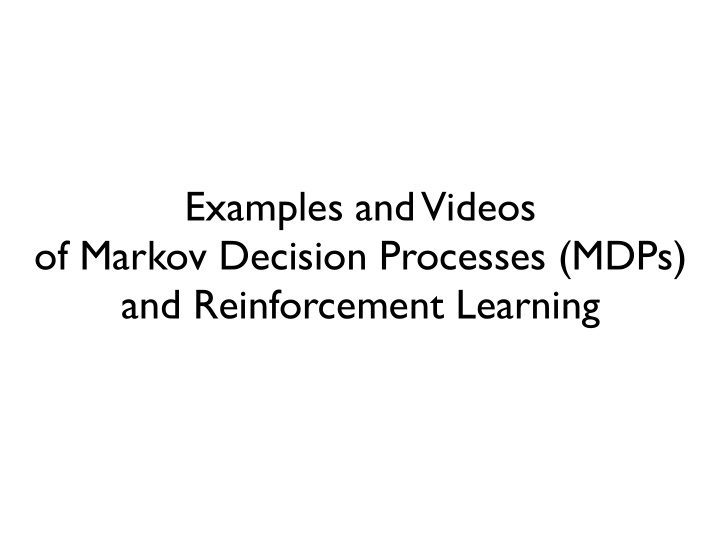



Examples and Videos of Markov Decision Processes (MDPs) and Reinforcement Learning
Artificial Intelligence is interaction to achieve a goal Environment action state reward Agent • complete agent • temporally situated • continual learning & planning • object is to affect environment • environment stochastic & uncertain
States, Actions, and Rewards
Hajime Kimura’s RL Robots After Before New Robot, Same algorithm Backward
Devilsticking Stefan Schaal & Chris Atkeson Finnegan Southey Univ. of Southern California University of Alberta “Model-based Reinforcement Learning of Devilsticking”
The RoboCup Soccer Competition
Autonomous Learning of Efficient Gait Kohl & Stone (UTexas) 2004
Policies • A policy maps each state to an action to take • Like a stimulus–response rule • We seek a policy that maximizes cumulative reward • The policy is a subgoal to achieving reward
The Reward Hypothesis The goal of intelligence is to maximize the cumulative sum of a single received number: “reward” = pleasure - pain Artificial Intelligence = reward maximization
Value
Value systems are hedonism with foresight We value situations according to how much reward we expect will follow them All efficient methods for solving sequential decision problems determine (learn or compute) “value functions” as an intermediate step Value systems are a means to reward, yet we care more about values than rewards
Pleasure = Immediate Reward ≠ good = Long-term Reward “Even enjoying yourself you call evil whenever it leads to the loss of a pleasure greater than its own, or lays up pains that outweigh its pleasures. ... Isn't it the same when we turn back to pain? To suffer pain you call good when it either rids us of greater pains than its own or leads to pleasures that outweigh them.” –Plato, Protagoras
Backgammon STATES: configurations of the playing board ( ≈ 10 20 ) ACTIONS: moves REWARDS: win: +1 lose: –1 else: 0 a “big” game
Tesauro, 1992-1995 TD-Gammon Action selection . . . Value . . . by 2-3 ply search . . . . . . TD Error V t + 1 − V t Start with a random Network Play millions of games against itself Learn a value function from this simulated experience Six weeks later it’s the best player of backgammon in the world
The Mountain Car Problem Goal SITUATIONS: car's position and velocity ACTIONS: three thrusts: forward, reverse, none REWARDS: always –1 until car Gravity wins reaches the goal No Discounting Minimum-Time-to-Goal Problem Moore, 1990
Value Functions Learned while solving the Mountain Car problem Goal region Minimize Time-to-Goal Value = estimated time to goal
Random Learned Hand-coded Hold
Temporal-difference (TD) error Do things seem to be getting better or worse, in terms of long-term reward, at this instant in time?
Brain reward systems What signal does this neuron carry? Honeybee Brain VUM Neuron Hammer, Menzel
TD error Brain reward systems seem to signal TD error Wolfram Schultz, et al.
World models
the actor-critic reinforcement learning architecture World or world model
“Autonomous helicopter flight via Reinforcement Learning” Ng (Stanford), Kim, Jordan, & Sastry (UC Berkeley) 2004
Reason as RL over Imagined Experience 1. Learn a predictive model of the world’s dynamics transition probabilities, expected immediate rewards 2. Use model to generate imaginary experiences internal thought trials, mental simulation (Craik, 1943) 3. Apply RL as if experience had really happened vicarious trial and error (Tolman, 1932)
GridWorld Example
Summary: RL’s Computational Theory of Mind Reward Policy Value Function Predictive Model A learned, time-varying prediction of imminent reward Key to all efficient methods for finding optimal policies This has nothing to do with either biology or computers
Summary: RL’s Computational Theory of Mind Reward Policy Value Function Predictive Model It’s all created from the scalar reward signal
Summary: RL’s Computational Theory of Mind Reward Policy Value Function Predictive Model It’s all created from the scalar reward signal together with the causal structure of the world
Recommend
More recommend